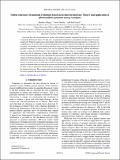| dc.contributor.author | Allegra, Michele | |
| dc.contributor.author | Giorda, Paolo | |
| dc.contributor.author | Lloyd, Seth | |
| dc.date.accessioned | 2016-04-15T14:59:21Z | |
| dc.date.available | 2016-04-15T14:59:21Z | |
| dc.date.issued | 2016-04 | |
| dc.date.submitted | 2016-01 | |
| dc.identifier.issn | 2469-9926 | |
| dc.identifier.issn | 2469-9934 | |
| dc.identifier.uri | http://hdl.handle.net/1721.1/102242 | |
| dc.description.abstract | Assessing the role of interference in natural and artificial quantum dynamical processes is a crucial task in quantum information theory. To this aim, an appropriate formalism is provided by the decoherent histories framework. While this approach has been deeply explored from different theoretical perspectives, it still lacks of a comprehensive set of tools able to concisely quantify the amount of coherence developed by a given dynamics. In this paper, we introduce and test different measures of the (average) coherence present in dissipative (Markovian) quantum evolutions, at various time scales and for different levels of environmentally induced decoherence. In order to show the effectiveness of the introduced tools, we apply them to a paradigmatic quantum process where the role of coherence is being hotly debated: exciton transport in photosynthetic complexes. To spot out the essential features that may determine the performance of the transport, we focus on a relevant trimeric subunit of the Fenna-Matthews-Olson complex and we use a simplified (Haken-Strobl) model for the system-bath interaction. Our analysis illustrates how the high efficiency of environmentally assisted transport can be traced back to a quantum recoil avoiding effect on the exciton dynamics, that preserves and sustains the benefits of the initial fast quantum delocalization of the exciton over the network. Indeed, for intermediate levels of decoherence, the bath is seen to selectively kill the negative interference between different exciton pathways, while retaining the initial positive one. The concepts and tools here developed show how the decoherent histories approach can be used to quantify the relation between coherence and efficiency in quantum dynamical processes. | en_US |
| dc.publisher | American Physical Society | en_US |
| dc.relation.isversionof | http://dx.doi.org/10.1103/PhysRevA.93.042312 | en_US |
| dc.rights | Article is made available in accordance with the publisher's policy and may be subject to US copyright law. Please refer to the publisher's site for terms of use. | en_US |
| dc.source | American Physical Society | en_US |
| dc.title | Global coherence of quantum evolutions based on decoherent histories: Theory and application to photosynthetic quantum energy transport | en_US |
| dc.type | Article | en_US |
| dc.identifier.citation | Allegra, Michele, Paolo Giorda, and Seth Lloyd. “Global Coherence of Quantum Evolutions Based on Decoherent Histories: Theory and Application to Photosynthetic Quantum Energy Transport.” Physical Review A 93, no. 4 (April 8, 2016). © 2016 American Physical Society | en_US |
| dc.contributor.department | Massachusetts Institute of Technology. Department of Mechanical Engineering | en_US |
| dc.contributor.department | Massachusetts Institute of Technology. Research Laboratory of Electronics | en_US |
| dc.contributor.mitauthor | Lloyd, Seth | en_US |
| dc.relation.journal | Physical Review A | en_US |
| dc.eprint.version | Final published version | en_US |
| dc.type.uri | http://purl.org/eprint/type/JournalArticle | en_US |
| eprint.status | http://purl.org/eprint/status/PeerReviewed | en_US |
| dc.date.updated | 2016-04-08T22:00:06Z | |
| dc.language.rfc3066 | en | |
| dc.rights.holder | American Physical Society | |
| dspace.orderedauthors | Allegra, Michele; Giorda, Paolo; Lloyd, Seth | en_US |
| mit.license | PUBLISHER_POLICY | en_US |
